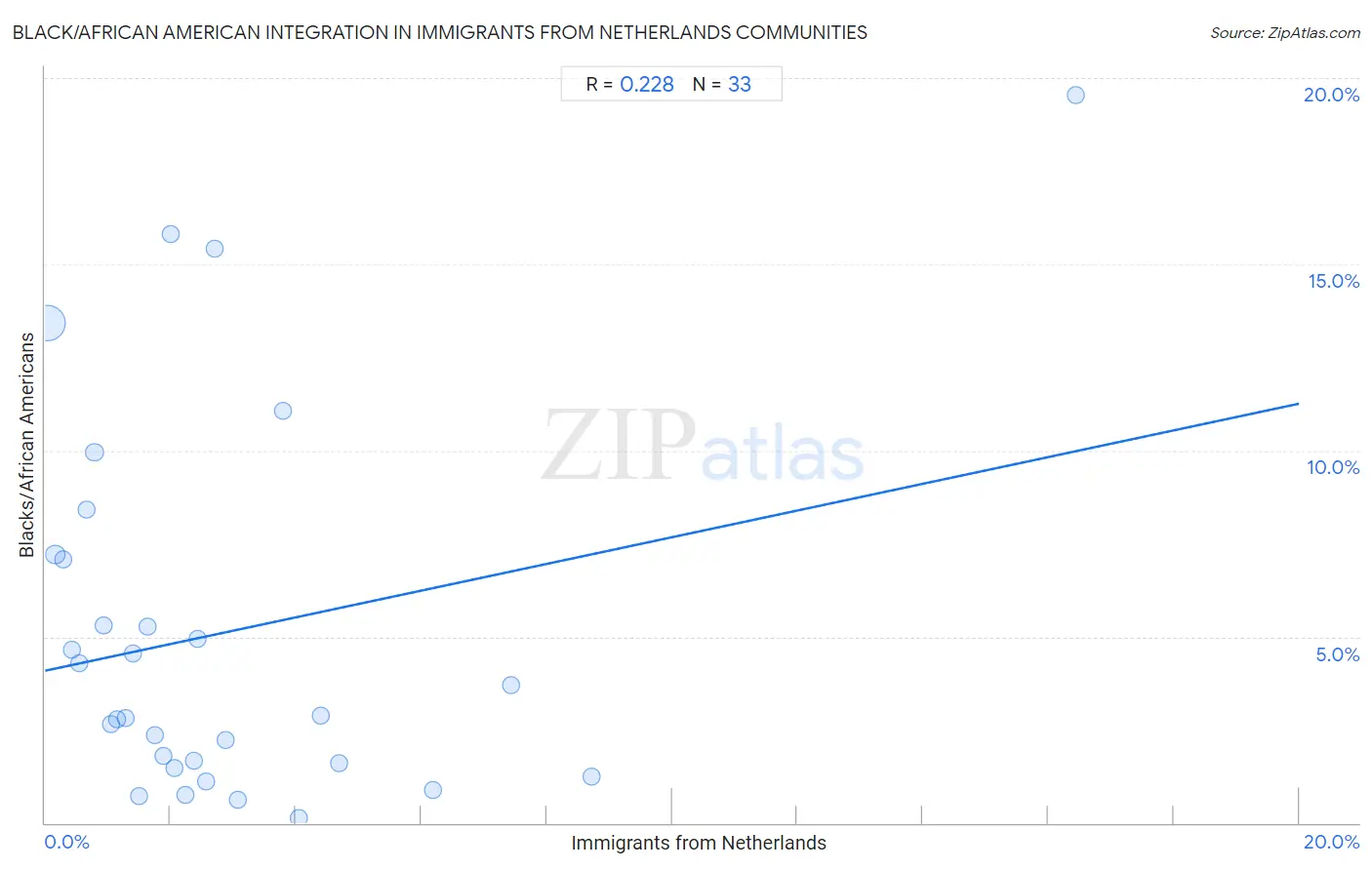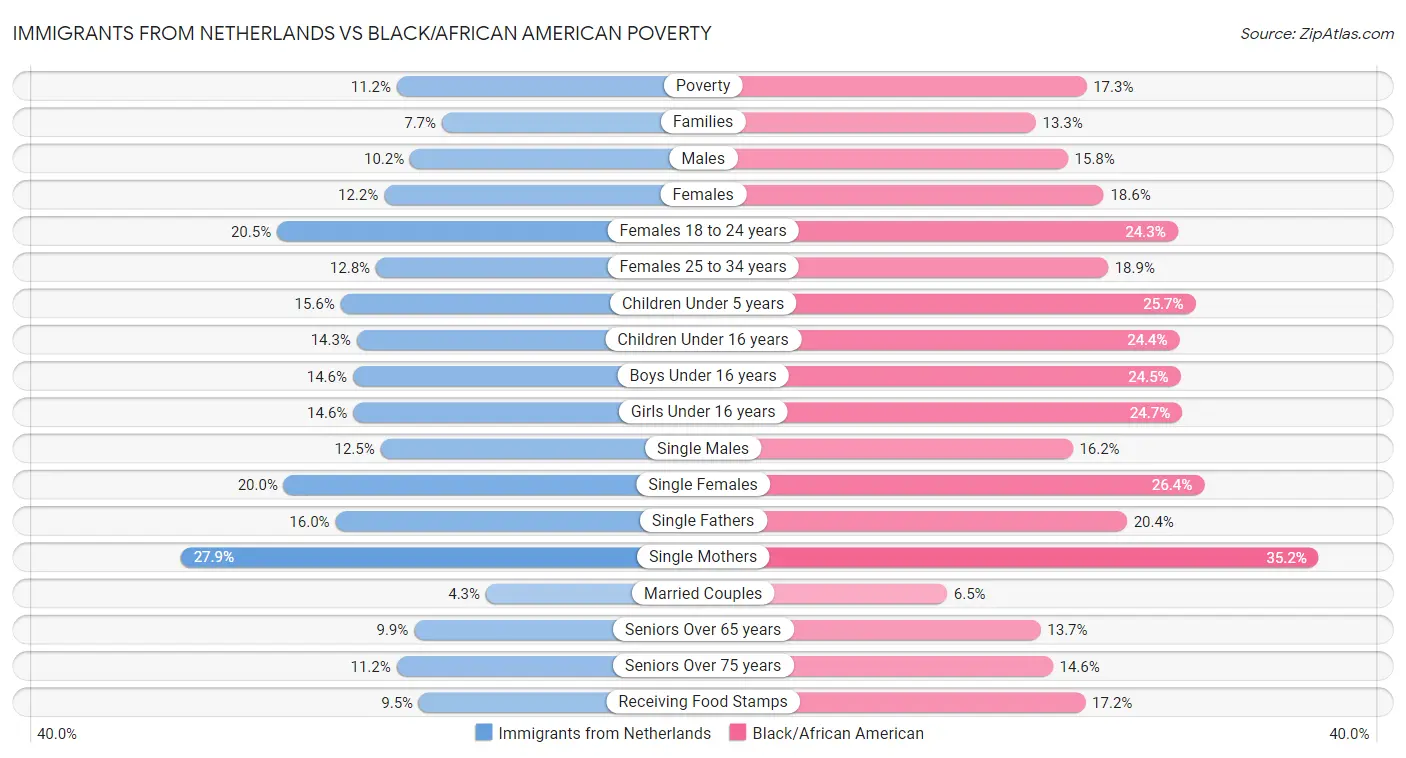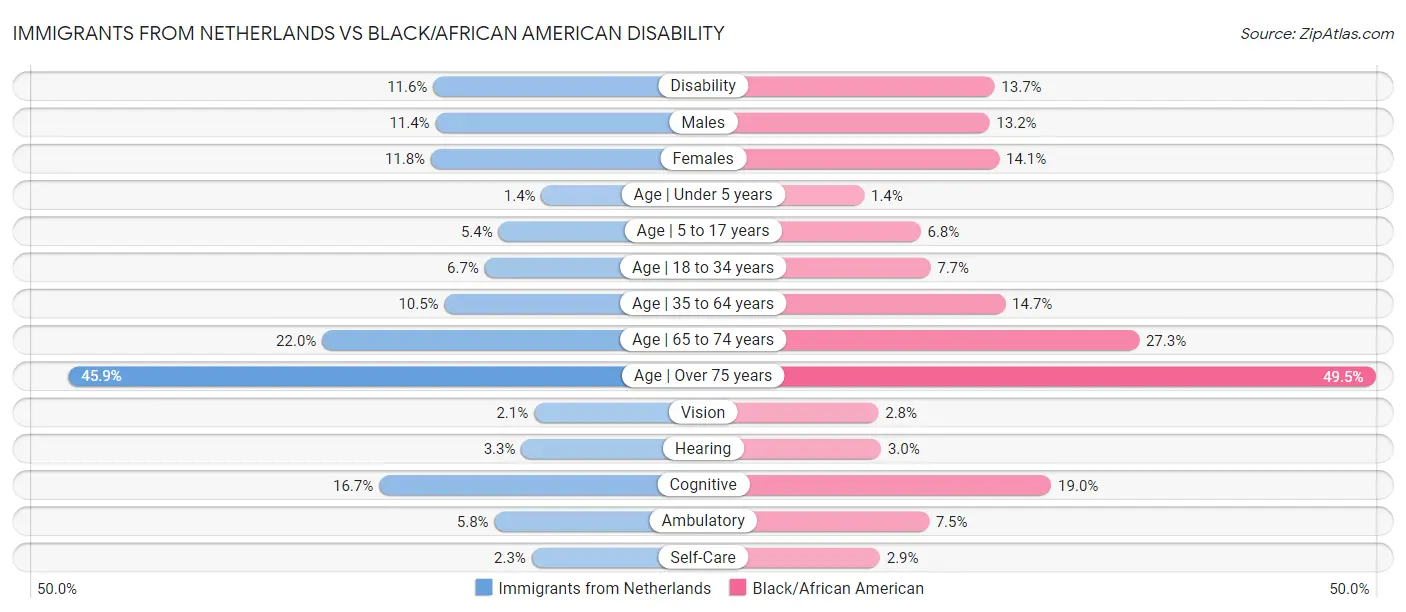Immigrants from Netherlands vs Black/African American Community Comparison
COMPARE
Immigrants from Netherlands
Black/African American
Social Comparison
Social Comparison
Immigrants from Netherlands
Blacks/African Americans
9,231
SOCIAL INDEX
89.8/ 100
SOCIAL RATING
26th/ 347
SOCIAL RANK
688
SOCIAL INDEX
4.4/ 100
SOCIAL RATING
338th/ 347
SOCIAL RANK
Black/African American Integration in Immigrants from Netherlands Communities
The statistical analysis conducted on geographies consisting of 236,833,966 people shows a weak positive correlation between the proportion of Blacks/African Americans within Immigrant from Netherlands communities in the United States with a correlation coefficient (R) of 0.228. On average, for every 1% (one percent) increase in Immigrants from Netherlands within a typical geography, there is an increase of 0.358% in Blacks/African Americans. To illustrate, in a geography comprising of 100,000 individuals, a rise of 1,000 Immigrants from Netherlands corresponds to an increase of 358.5 Blacks/African Americans.

Immigrants from Netherlands vs Black/African American Income
When considering income, the most significant differences between Immigrants from Netherlands and Black/African American communities in the United States are seen in householder income ages 25 - 44 years ($105,082 compared to $73,370, a difference of 43.2%), householder income ages 45 - 64 years ($111,982 compared to $78,556, a difference of 42.5%), and per capita income ($50,458 compared to $35,564, a difference of 41.9%). Conversely, both communities are more comparable in terms of householder income under 25 years ($52,592 compared to $44,381, a difference of 18.5%), median female earnings ($41,870 compared to $35,315, a difference of 18.6%), and median earnings ($50,818 compared to $40,085, a difference of 26.8%).

| Income Metric | Immigrants from Netherlands | Black/African American |
| Per Capita Income | Exceptional $50,458 | Tragic $35,564 |
| Median Family Income | Exceptional $114,987 | Tragic $81,912 |
| Median Household Income | Exceptional $94,411 | Tragic $67,573 |
| Median Earnings | Exceptional $50,818 | Tragic $40,085 |
| Median Male Earnings | Exceptional $61,096 | Tragic $45,523 |
| Median Female Earnings | Exceptional $41,870 | Tragic $35,315 |
| Householder Age | Under 25 years | Good $52,592 | Tragic $44,381 |
| Householder Age | 25 - 44 years | Exceptional $105,082 | Tragic $73,370 |
| Householder Age | 45 - 64 years | Exceptional $111,982 | Tragic $78,556 |
| Householder Age | Over 65 years | Exceptional $66,463 | Tragic $50,779 |
| Wage/Income Gap | Tragic 28.5% | Exceptional 21.7% |
Immigrants from Netherlands vs Black/African American Poverty
When considering poverty, the most significant differences between Immigrants from Netherlands and Black/African American communities in the United States are seen in receiving food stamps (9.5% compared to 17.2%, a difference of 80.3%), family poverty (7.7% compared to 13.3%, a difference of 72.1%), and child poverty under the age of 16 (14.3% compared to 24.4%, a difference of 70.6%). Conversely, both communities are more comparable in terms of female poverty among 18-24 year olds (20.5% compared to 24.3%, a difference of 18.6%), single mother poverty (27.9% compared to 35.2%, a difference of 26.1%), and single father poverty (16.0% compared to 20.4%, a difference of 27.6%).

| Poverty Metric | Immigrants from Netherlands | Black/African American |
| Poverty | Exceptional 11.2% | Tragic 17.3% |
| Families | Exceptional 7.7% | Tragic 13.3% |
| Males | Exceptional 10.2% | Tragic 15.8% |
| Females | Exceptional 12.2% | Tragic 18.6% |
| Females 18 to 24 years | Poor 20.5% | Tragic 24.3% |
| Females 25 to 34 years | Exceptional 12.8% | Tragic 18.9% |
| Children Under 5 years | Exceptional 15.6% | Tragic 25.7% |
| Children Under 16 years | Exceptional 14.3% | Tragic 24.4% |
| Boys Under 16 years | Exceptional 14.6% | Tragic 24.5% |
| Girls Under 16 years | Exceptional 14.6% | Tragic 24.7% |
| Single Males | Excellent 12.5% | Tragic 16.2% |
| Single Females | Exceptional 20.0% | Tragic 26.4% |
| Single Fathers | Excellent 16.0% | Tragic 20.4% |
| Single Mothers | Exceptional 27.9% | Tragic 35.2% |
| Married Couples | Exceptional 4.3% | Tragic 6.5% |
| Seniors Over 65 years | Exceptional 9.9% | Tragic 13.7% |
| Seniors Over 75 years | Exceptional 11.2% | Tragic 14.6% |
| Receiving Food Stamps | Exceptional 9.5% | Tragic 17.2% |
Immigrants from Netherlands vs Black/African American Unemployment
When considering unemployment, the most significant differences between Immigrants from Netherlands and Black/African American communities in the United States are seen in unemployment among women with children under 6 years (7.0% compared to 10.3%, a difference of 47.3%), unemployment among women with children under 18 years (5.2% compared to 7.3%, a difference of 39.4%), and male unemployment (5.0% compared to 6.9%, a difference of 38.6%). Conversely, both communities are more comparable in terms of unemployment among ages 65 to 74 years (5.2% compared to 5.8%, a difference of 10.8%), unemployment among seniors over 65 years (5.0% compared to 5.5%, a difference of 11.3%), and unemployment among ages 60 to 64 years (4.7% compared to 5.3%, a difference of 13.1%).

| Unemployment Metric | Immigrants from Netherlands | Black/African American |
| Unemployment | Exceptional 4.9% | Tragic 6.6% |
| Males | Exceptional 5.0% | Tragic 6.9% |
| Females | Exceptional 5.0% | Tragic 6.5% |
| Youth < 25 | Exceptional 11.1% | Tragic 14.5% |
| Age | 16 to 19 years | Exceptional 17.0% | Tragic 21.4% |
| Age | 20 to 24 years | Exceptional 9.9% | Tragic 12.7% |
| Age | 25 to 29 years | Exceptional 6.2% | Tragic 8.6% |
| Age | 30 to 34 years | Excellent 5.3% | Tragic 7.2% |
| Age | 35 to 44 years | Exceptional 4.5% | Tragic 6.1% |
| Age | 45 to 54 years | Good 4.4% | Tragic 5.4% |
| Age | 55 to 59 years | Excellent 4.7% | Tragic 5.5% |
| Age | 60 to 64 years | Exceptional 4.7% | Tragic 5.3% |
| Age | 65 to 74 years | Exceptional 5.2% | Tragic 5.8% |
| Seniors > 65 | Exceptional 5.0% | Tragic 5.5% |
| Seniors > 75 | Exceptional 8.1% | Tragic 9.4% |
| Women w/ Children < 6 | Exceptional 7.0% | Tragic 10.3% |
| Women w/ Children 6 to 17 | Good 8.9% | Tragic 11.4% |
| Women w/ Children < 18 | Exceptional 5.2% | Tragic 7.3% |
Immigrants from Netherlands vs Black/African American Labor Participation
When considering labor participation, the most significant differences between Immigrants from Netherlands and Black/African American communities in the United States are seen in in labor force | age 45-54 (82.9% compared to 79.3%, a difference of 4.5%), in labor force | age 16-19 (37.8% compared to 36.5%, a difference of 3.6%), and in labor force | age 20-64 (79.5% compared to 76.8%, a difference of 3.6%). Conversely, both communities are more comparable in terms of in labor force | age > 16 (64.5% compared to 63.4%, a difference of 1.7%), in labor force | age 30-34 (84.6% compared to 82.8%, a difference of 2.2%), and in labor force | age 20-24 (75.9% compared to 73.9%, a difference of 2.7%).

| Labor Participation Metric | Immigrants from Netherlands | Black/African American |
| In Labor Force | Age > 16 | Tragic 64.5% | Tragic 63.4% |
| In Labor Force | Age 20-64 | Average 79.5% | Tragic 76.8% |
| In Labor Force | Age 16-19 | Exceptional 37.8% | Average 36.5% |
| In Labor Force | Age 20-24 | Exceptional 75.9% | Tragic 73.9% |
| In Labor Force | Age 25-29 | Exceptional 85.1% | Tragic 82.6% |
| In Labor Force | Age 30-34 | Average 84.6% | Tragic 82.8% |
| In Labor Force | Age 35-44 | Good 84.5% | Tragic 82.2% |
| In Labor Force | Age 45-54 | Good 82.9% | Tragic 79.3% |
Immigrants from Netherlands vs Black/African American Family Structure
When considering family structure, the most significant differences between Immigrants from Netherlands and Black/African American communities in the United States are seen in single mother households (5.6% compared to 9.0%, a difference of 60.5%), births to unmarried women (29.9% compared to 44.3%, a difference of 48.0%), and married-couple households (48.2% compared to 38.5%, a difference of 25.2%). Conversely, both communities are more comparable in terms of family households with children (26.9% compared to 26.5%, a difference of 1.8%), family households (63.8% compared to 61.5%, a difference of 3.8%), and average family size (3.14 compared to 3.27, a difference of 4.2%).

| Family Structure Metric | Immigrants from Netherlands | Black/African American |
| Family Households | Tragic 63.8% | Tragic 61.5% |
| Family Households with Children | Tragic 26.9% | Tragic 26.5% |
| Married-couple Households | Exceptional 48.2% | Tragic 38.5% |
| Average Family Size | Tragic 3.14 | Exceptional 3.27 |
| Single Father Households | Exceptional 2.2% | Tragic 2.4% |
| Single Mother Households | Exceptional 5.6% | Tragic 9.0% |
| Currently Married | Exceptional 48.5% | Tragic 39.6% |
| Divorced or Separated | Excellent 11.9% | Tragic 13.6% |
| Births to Unmarried Women | Exceptional 29.9% | Tragic 44.3% |
Immigrants from Netherlands vs Black/African American Vehicle Availability
When considering vehicle availability, the most significant differences between Immigrants from Netherlands and Black/African American communities in the United States are seen in no vehicles in household (9.4% compared to 11.9%, a difference of 26.4%), 4 or more vehicles in household (6.6% compared to 5.5%, a difference of 20.8%), and 3 or more vehicles in household (20.4% compared to 17.3%, a difference of 18.0%). Conversely, both communities are more comparable in terms of 1 or more vehicles in household (90.8% compared to 88.2%, a difference of 2.9%), 2 or more vehicles in household (57.5% compared to 50.9%, a difference of 13.1%), and 3 or more vehicles in household (20.4% compared to 17.3%, a difference of 18.0%).

| Vehicle Availability Metric | Immigrants from Netherlands | Black/African American |
| No Vehicles Available | Exceptional 9.4% | Tragic 11.9% |
| 1+ Vehicles Available | Exceptional 90.8% | Tragic 88.2% |
| 2+ Vehicles Available | Exceptional 57.5% | Tragic 50.9% |
| 3+ Vehicles Available | Exceptional 20.4% | Tragic 17.3% |
| 4+ Vehicles Available | Excellent 6.6% | Tragic 5.5% |
Immigrants from Netherlands vs Black/African American Education Level
When considering education level, the most significant differences between Immigrants from Netherlands and Black/African American communities in the United States are seen in doctorate degree (2.5% compared to 1.4%, a difference of 71.9%), professional degree (5.8% compared to 3.4%, a difference of 70.5%), and master's degree (18.1% compared to 12.1%, a difference of 50.1%). Conversely, both communities are more comparable in terms of nursery school (98.4% compared to 97.9%, a difference of 0.45%), kindergarten (98.3% compared to 97.9%, a difference of 0.45%), and 1st grade (98.3% compared to 97.9%, a difference of 0.46%).

| Education Level Metric | Immigrants from Netherlands | Black/African American |
| No Schooling Completed | Exceptional 1.7% | Average 2.1% |
| Nursery School | Exceptional 98.4% | Fair 97.9% |
| Kindergarten | Exceptional 98.3% | Fair 97.9% |
| 1st Grade | Exceptional 98.3% | Fair 97.9% |
| 2nd Grade | Exceptional 98.3% | Fair 97.8% |
| 3rd Grade | Exceptional 98.2% | Fair 97.7% |
| 4th Grade | Exceptional 98.0% | Fair 97.4% |
| 5th Grade | Exceptional 97.8% | Fair 97.3% |
| 6th Grade | Exceptional 97.6% | Fair 97.0% |
| 7th Grade | Exceptional 96.8% | Average 96.0% |
| 8th Grade | Exceptional 96.5% | Fair 95.6% |
| 9th Grade | Exceptional 95.8% | Fair 94.6% |
| 10th Grade | Exceptional 94.9% | Tragic 93.2% |
| 11th Grade | Exceptional 93.9% | Tragic 91.4% |
| 12th Grade, No Diploma | Exceptional 92.7% | Tragic 89.3% |
| High School Diploma | Exceptional 91.0% | Tragic 87.0% |
| GED/Equivalency | Exceptional 88.0% | Tragic 82.8% |
| College, Under 1 year | Exceptional 70.0% | Tragic 59.4% |
| College, 1 year or more | Exceptional 64.2% | Tragic 53.3% |
| Associate's Degree | Exceptional 51.4% | Tragic 39.1% |
| Bachelor's Degree | Exceptional 43.3% | Tragic 30.9% |
| Master's Degree | Exceptional 18.1% | Tragic 12.1% |
| Professional Degree | Exceptional 5.8% | Tragic 3.4% |
| Doctorate Degree | Exceptional 2.5% | Tragic 1.4% |
Immigrants from Netherlands vs Black/African American Disability
When considering disability, the most significant differences between Immigrants from Netherlands and Black/African American communities in the United States are seen in disability age 35 to 64 (10.5% compared to 14.7%, a difference of 39.7%), vision disability (2.1% compared to 2.8%, a difference of 32.1%), and ambulatory disability (5.8% compared to 7.5%, a difference of 28.9%). Conversely, both communities are more comparable in terms of disability age under 5 (1.4% compared to 1.4%, a difference of 2.1%), disability age over 75 (45.9% compared to 49.5%, a difference of 7.9%), and hearing disability (3.3% compared to 3.0%, a difference of 8.9%).

| Disability Metric | Immigrants from Netherlands | Black/African American |
| Disability | Good 11.6% | Tragic 13.7% |
| Males | Fair 11.4% | Tragic 13.2% |
| Females | Exceptional 11.8% | Tragic 14.1% |
| Age | Under 5 years | Tragic 1.4% | Tragic 1.4% |
| Age | 5 to 17 years | Exceptional 5.4% | Tragic 6.8% |
| Age | 18 to 34 years | Fair 6.7% | Tragic 7.7% |
| Age | 35 to 64 years | Exceptional 10.5% | Tragic 14.7% |
| Age | 65 to 74 years | Exceptional 22.0% | Tragic 27.3% |
| Age | Over 75 years | Exceptional 45.9% | Tragic 49.5% |
| Vision | Excellent 2.1% | Tragic 2.8% |
| Hearing | Tragic 3.3% | Fair 3.0% |
| Cognitive | Exceptional 16.7% | Tragic 19.0% |
| Ambulatory | Exceptional 5.8% | Tragic 7.5% |
| Self-Care | Exceptional 2.3% | Tragic 2.9% |